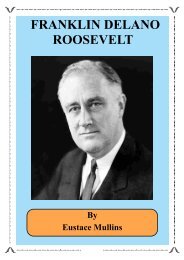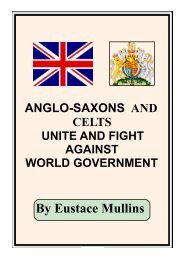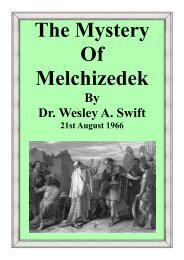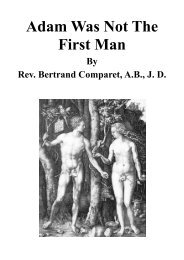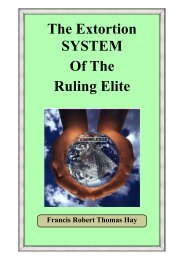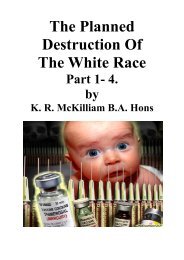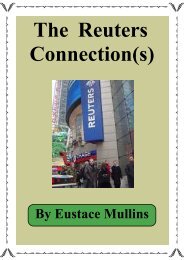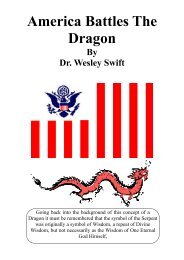Curse of Cannan - The New Ensign
Curse of Cannan - The New Ensign
Curse of Cannan - The New Ensign
You also want an ePaper? Increase the reach of your titles
YUMPU automatically turns print PDFs into web optimized ePapers that Google loves.
<strong>The</strong> Venetians were always known as masters <strong>of</strong> intrigue; they aided the Turks in the conquest<br />
<strong>of</strong> Constantinople in 1453, which ended the twelve hundred-year reign <strong>of</strong> the Emperors <strong>of</strong><br />
Byzantium. <strong>The</strong> Turks were shocked at the rapacity <strong>of</strong> the Venetians, who carried <strong>of</strong>f much <strong>of</strong><br />
the city's legendary art treasures, gold, and jewelry. After they had returned home with their loot,<br />
the Venetians actively disputed control <strong>of</strong> the Mediterranean with the Turks, fighting them<br />
continually from 1453 to 1718. Venice had now become the headquarters <strong>of</strong> a ruthless,<br />
social-climbing band <strong>of</strong> entrepreneurs who purchased titles for themselves, or created them out<br />
<strong>of</strong> thin air, built splendid mansions, and collected the art treasures <strong>of</strong> Europe. <strong>The</strong>y financed their<br />
new lifestyle with the enormous sums which they garnered from trade, piracy, and money lending.<br />
From the year 1171, this group became known throughout Europe as "the black nobility," because<br />
they were <strong>of</strong> Canaanite origin, as contrasted to the fairskinned nobility <strong>of</strong> the people <strong>of</strong> Shem.<br />
<strong>The</strong> black nobility gradually infiltrated the noble families <strong>of</strong> Europe; today, they constitute most<br />
<strong>of</strong> the surviving European royalty.<br />
Because <strong>of</strong> their ruthlessness, the Venetians attained a worldwide reputation as international<br />
arbiters <strong>of</strong> intrigue, revolution, poisoning, and other forms <strong>of</strong> assassination. <strong>The</strong>y <strong>of</strong>ten conspired<br />
to bankrupt any opponent, and were known to cruelly rape the daughters <strong>of</strong> anyone in the<br />
oligarchy who dared to oppose them. From Venice, they rapidly spread northward like some<br />
new form <strong>of</strong> plague, setting up businesses and banking establishments in the northern cities <strong>of</strong><br />
Italy. <strong>The</strong>y bought more titles and intermarried with impoverished families <strong>of</strong> the old nobility.<br />
In Florence, the preeminent family was the de Medicis, who used their wealth to establish an<br />
Accademica which foisted humanism on the world. <strong>The</strong> de Medici established Florence as the<br />
European center <strong>of</strong> the black nobility, or Guelphs, as they were now called.<br />
<strong>The</strong> black nobility also established close ties with the ruling families <strong>of</strong> England, through the<br />
Savoy and Este families. <strong>The</strong> Savoys ruled Italy from 1146 to 1945. <strong>The</strong> Este family ruled Ferrara<br />
from the twelfth century until Italy was united in 1860. Peter, the ninth Count <strong>of</strong> Savoy, married<br />
his niece, Eleanor, to King Henry III <strong>of</strong> England, and thereby became his privy councillor. King<br />
Henry granted him large estates, with the title <strong>of</strong> Earl <strong>of</strong> Richmond. Peter brought in other<br />
members <strong>of</strong> the black nobility to marry English noblemen, who included Richard de Burgh and<br />
the Earl <strong>of</strong> Lincoln. Peter's younger brother, Boniface, was appointed Archbishop <strong>of</strong> Canterbury.<br />
Peter died in 1268.<br />
<strong>The</strong> founders <strong>of</strong> the European dynasties which lasted into the twentieth century were Rupert,<br />
Count <strong>of</strong> Nassau, who died in 1124, and Christian, Count <strong>of</strong> Oldenbourg, who died in 1167.<br />
From Rupert came the Hesse-Darmstadt line, the Hesse-Cassel line, the Dukes <strong>of</strong> Luxembourg,<br />
the Battenborgs, the Prince <strong>of</strong> Orange and Nassau, and the Kings <strong>of</strong> the Netherlands. From<br />
Christian came the Kings <strong>of</strong> Denmark and Norway, the Schleswig-Holstein line, and the<br />
Hanovers, who became Kings <strong>of</strong> Great Britain from 1717 to the present time. Also <strong>of</strong> the black<br />
nobility were the Dukes <strong>of</strong> Normandy, the Angevins and the Plantagenets, who became the Tudor<br />
and Stuart kings <strong>of</strong> England, the Saxe-Coburgs, and the Wittelsbachs.<br />
<strong>The</strong> Hanover line was always deeply involved with Freemasonry. <strong>The</strong> Hanovers became Kings<br />
<strong>of</strong> England in 1717. hat same year, the first Grand Lodge was established in England. <strong>The</strong> Masons<br />
Company had been established in England in 1376 in London and had obtained a grant <strong>of</strong> arms<br />
from King Henry VIII in 1472; it was incorporated by King Charles n in 1677. But this was guild<br />
masonry, the builders, which was taken over in 1717 by "speculative Masonry," which opened<br />
the groups to members <strong>of</strong> other pr<strong>of</strong>essions. A poem appeared in London in 1723, "<strong>The</strong><br />
Freemasons; a Hudibrastic Poem," which rhymed: "If history be not ancient fable, Free Masons<br />
came from the Tower <strong>of</strong> Babel"<br />
A tradition was established that a member <strong>of</strong> the royal family, or someone with close ties to<br />
Buckingham Palace, would be named Grand Master <strong>of</strong> the English Lodges. From 1782, the Duke<br />
<strong>of</strong> Cumberland, the Prince <strong>of</strong> Wales, and the Duke <strong>of</strong> Sussex were grand masters. <strong>The</strong> Duke <strong>of</strong><br />
Sussex was King George II's second son; he married Louise, daughter <strong>of</strong> the King <strong>of</strong> Prussia.<br />
( Page 41)



